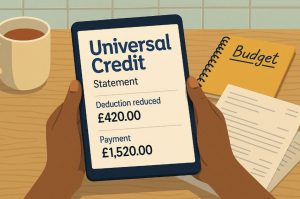Starting 30 April 2025, a major change to Universal Credit rules is set to provide a financial uplift for over a million households in the UK. Introduced through the Fair Repayment Rate, this policy lowers the maximum amount that can be deducted from a claimant’s standard allowance for debt repayment from 25% down to 15%.
This reform, announced in the 2024 Autumn Budget and delivered by the Department for Work and Pensions (DWP), is expected to leave recipients with an average of £420 more each year. Among the 1.2 million households set to benefit are 700,000 families with children, making this a particularly impactful move in the fight against poverty.
More than just a technical adjustment, the policy reflects a broader shift in welfare strategy—one that aims to balance debt recovery with financial security. It forms a core part of the government’s Plan for Change, which prioritises income protection, employment support, and child welfare in response to ongoing economic pressures.
What is the £420 Universal Credit boost?

At the heart of this reform is the concept of reducing the amount the government deducts from Universal Credit claimants’ monthly payments. When individuals owe money to the DWP often because they’ve taken out an advance to bridge the five-week wait for their first payment or have benefit overpayments the government traditionally reclaims that debt through deductions.
Until now, those deductions could be up to 25% of a claimant’s standard allowance. That often left people struggling to meet basic needs like rent, food, and utilities.
How does £420 Universal Credit boost work?
The new Fair Repayment Rate brings this deduction cap down to 15%, providing significant monthly relief. Here’s how that translates:
- Previous deduction: Up to 25% of the standard allowance
- New deduction: Capped at 15%
- Average increase in retained benefit: Approximately £35 per month
- Annual improvement: Around £420 more per year per affected household
It’s not technically an increase in the Universal Credit amount, but rather a reduction in how much is taken away, allowing recipients to retain more of their entitlement.
When did the new Universal Credit deduction rule come into effect?
The Fair Repayment Rate officially came into effect on 30 April 2025, and applies to all assessment periods beginning on or after that date. Assessment periods are the monthly cycles in which Universal Credit is calculated and paid.
If a claimant’s assessment period started before 30 April, their existing repayment cap of 25% would still apply for that period. From the next cycle onward, however, the new 15% cap will be applied automatically there is no need for claimants to opt in or reapply.
This seamless transition helps claimants without introducing additional bureaucracy, which is especially beneficial for those already navigating complex personal or financial challenges.
Who benefits from the Fair Repayment Rate changes?
According to official government estimates, 1.2 million households will benefit from this change in 2025. Among them:
- 700,000 households have children, making this reform crucial in combating child poverty
- A large percentage are working families on low incomes, struggling with rising living costs
- Many are repaying Universal Credit advances, taken out during waiting periods or emergencies
The policy is tailored for vulnerable individuals who would otherwise face hard choices between repaying debts and meeting basic needs. By reducing the clawback rate, the government enables families to keep more of their income, helping them cover essentials without resorting to high-interest borrowing or food banks.
What is the government’s Plan for Change and how does this fit in?

The Plan for Change is a wider strategy launched by the UK government to address rising inequality, tackle the cost of living crisis, and ensure work pays. Key pillars of the Plan include:
- Boosting financial resilience for working families
- Investing in job opportunities via the Get Britain Working White Paper
- Enhancing child welfare, including the rollout of free breakfast clubs
- Raising the National Minimum and Living Wage
- Extending the Household Support Fund to 2026
The Universal Credit 420 boost fits into this broader agenda by supporting low-income families with real, tangible financial relief. It’s a step toward modernising the welfare system while maintaining fiscal responsibility.
The government has also confirmed that this policy marks the first step in a wider review of Universal Credit, to ensure that the system is working effectively for those who need it most.
What did government leaders say about the Universal Credit reform?
Chancellor of the Exchequer Rachel Reeves said
“As announced at the budget, from today, 1.2 million households will keep more of their Universal Credit and will be on average £420 better off a year. This is our plan for change delivering, easing the cost of living and putting more money into the pockets of working people.”
Work and Pensions Secretary Liz Kendall added
“We are taking decisive action to ensure working people keep more of the benefits they’re entitled to which will boost financial security and improve living standards up and down the country.”
These comments highlight the dual goal of debt recovery and economic support, ensuring people are both repaying what they owe and retaining enough to live on.
How does the Fair Repayment Rate help with sustainable debt repayment?
High deduction rates often led to a cycle of debt, as claimants fell short of meeting basic needs and turned to short-term loans or credit cards. This left many worse off than before.
By reducing the deduction cap to 15%, the government makes it easier for individuals to:
- Budget monthly expenses without financial shock
- Avoid crisis borrowing or falling behind on rent and utilities
- Repay debts over time, instead of defaulting or escalating hardship
The policy reflects a shift in approach prioritising long-term financial sustainability over aggressive debt recovery.
How does this reform support working families and children?

Low-income families with children are some of the most vulnerable in society. Many face persistent financial insecurity due to a combination of:
- High housing costs
- Childcare expenses
- Inconsistent work hours
With 700,000 families with children directly benefiting, this policy:
- Improves food and housing security
- Supports educational outcomes by reducing stress at home
- Helps parents avoid making difficult trade-offs between essentials
It also complements other child-focused policies like free breakfast clubs and early learning support.
What does this mean for those repaying Universal Credit advances?
One of the main reasons deductions are taken from Universal Credit is to recover advance payments, which are often claimed when individuals first apply for Universal Credit to bridge the five-week waiting period.
Under the new rules:
- Repayments on advances are capped at 15%, not 25%
- Repayment terms may be longer, but monthly budgets are healthier
- Claimants can still request lower repayment rates in cases of hardship
The DWP continues to assess each situation individually but applies this cap universally unless a lower rate is already in place.
Facts About the Universal Credit £420 Boost
| Aspect | Details |
| Policy Name | Fair Repayment Rate |
| Previous Deduction Limit | 25% of standard allowance |
| New Deduction Limit | 15% of standard allowance |
| Estimated Annual Boost | £420 per household |
| Launch Date | 30 April 2025 |
| Targeted Households | 1.2 million, including 700,000 with children |
| Policy Context | Government’s Plan for Change |
| Announced By | Chancellor Rachel Reeves and DWP Secretary Liz Kendall |
How can claimants check their deductions and benefit from this change?
To make the most of the Universal Credit 420 boost, claimants should:
- Log in to their Universal Credit online journal
- Review their monthly statements for deduction breakdowns
- Confirm that deductions have dropped to the new 15% rate
- Use budgeting tools such as the DWP’s benefits calculator
- Contact their work coach or caseworker for questions or adjustments
Financial advice services like MoneyHelper, StepChange, and Citizens Advice are also equipped to assist claimants with understanding the impact of this reform.
What is the long-term goal of the Universal Credit repayment reform?

A shift toward sustainable welfare policy
The Fair Repayment Rate represents more than just a change in deduction percentages. it’s part of a strategic transition in welfare policy. By reducing the financial strain on claimants, the government aims to foster economic independence and reduce long-term dependency on crisis support.
Foundations for future Universal Credit changes
This reform lays the groundwork for broader reviews of the Universal Credit system. Government departments are expected to assess other areas such as:
- The five-week wait for first payments
- The complexity of claim procedures
- The adequacy of standard allowances
This forward-thinking approach shows intent to modernise the welfare system to meet the evolving needs of working people and families.
How does the £420 Universal Credit boost affect the wider economy?
Increased household spending power
With more money in their pockets, low-income households are expected to spend more on essentials like food, clothing, and utilities. This stimulates local economies, especially in deprived areas where Universal Credit is a major income source.
Reduced strain on support services
Debt charities, food banks, and local councils may see reduced demand for emergency aid and crisis loans. The ability to retain more income helps claimants avoid falling into deeper financial hardship, thereby easing pressure on public and third-sector services.
What support remains for those still facing financial hardship despite the change?

While the Fair Repayment Rate offers significant relief, not all financial challenges will disappear overnight for low-income households. Many families still face complex, overlapping pressures such as high rents, energy costs, childcare expenses, and food insecurity.
For those who continue to struggle, there are additional support mechanisms available across the UK:
- Household Support Fund (HSF): Recently extended with £742 million in new funding, the HSF helps families with essentials like heating, food, and clothing. Distributed via local councils, it targets urgent financial needs.
- Discretionary Housing Payments: Available to claimants facing rent shortfalls or eviction threats
- Free school meals and breakfast clubs: These ease pressure on family food budgets and improve child nutrition and school performance
- Jobcentre support: Expanded career services, youth guarantees, and skills training under the Get Britain Working plan
- Debt advice charities: StepChange, National Debtline, and Citizens Advice provide free financial coaching and budgeting help
The government’s goal is to combine income retention (like the £420 boost) with direct local support and employment assistance offering a more comprehensive response to poverty.
Conclusion
The introduction of the Fair Repayment Rate marks a meaningful shift in how the UK government approaches welfare, debt recovery, and support for low-income households. By lowering the maximum deduction from 25% to 15%, this reform ensures that an estimated 1.2 million households including 700,000 with children can retain more of their Universal Credit entitlement, leading to an average boost of £420 per year.
This change does more than increase take-home benefits; it addresses the root causes of financial vulnerability, reduces the risk of hardship, and promotes sustainable debt repayment. Early feedback from charities, councils, and economic analysts indicates a positive trend, with reduced reliance on crisis services and increased financial breathing space for families.
As part of the wider Plan for Change, the Universal Credit reform is just the beginning. It reflects a renewed commitment to ensuring the welfare system evolves with the needs of working people and those facing the pressures of the ongoing cost-of-living crisis.
For claimants, support organisations, and policymakers alike, the £420 boost is a step in the right direction towards a fairer, more compassionate, and more functional welfare state.
FAQs About Universal Credit 420 Boost
Who is eligible for the Universal Credit deduction reduction?
Anyone with deductions for debt repayments in their Universal Credit assessment period starting on or after 30 April 2025.
Does this affect other elements like housing or childcare support?
No, the change only applies to the standard allowance portion of Universal Credit.
Will everyone’s deductions drop to 15% automatically?
Yes, unless a lower deduction rate is already in place for hardship reasons. The cap is now a maximum.
Can I request a lower rate than 15%?
Yes. In cases of financial hardship, the DWP can approve further reductions or temporary suspension of repayments.
Does this policy apply across the UK?
Yes, the Fair Repayment Rate is a UK-wide policy applicable to all Universal Credit claimants.
Will this affect the length of my debt repayment?
Yes. While monthly deductions will be lower, it may take longer to repay the full amount.
Are other Universal Credit changes expected in 2025?
Yes, including improvements to disability assessments, a new jobs and careers service, and further cost of living support.









Leave feedback about this